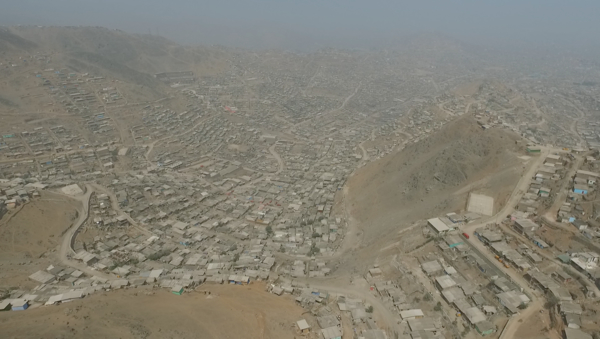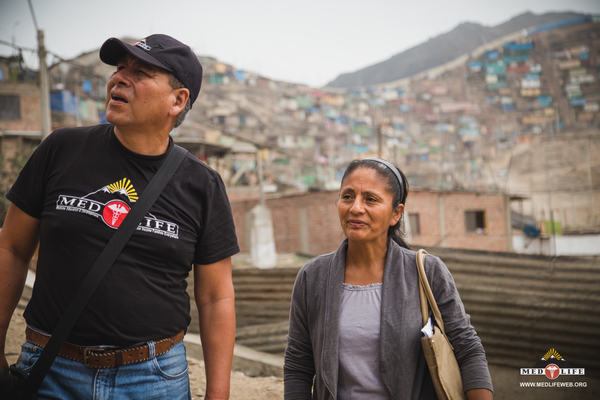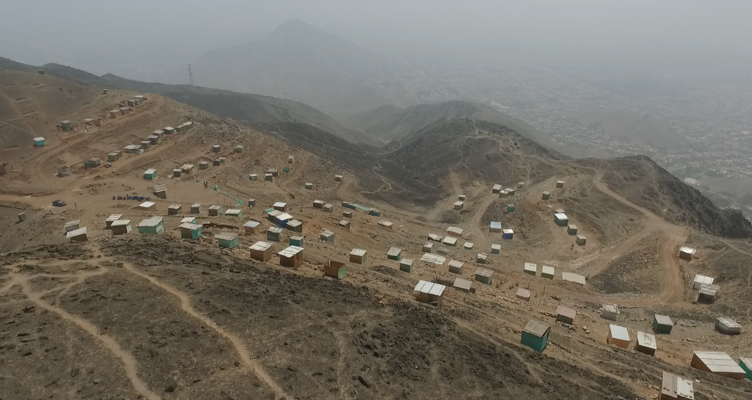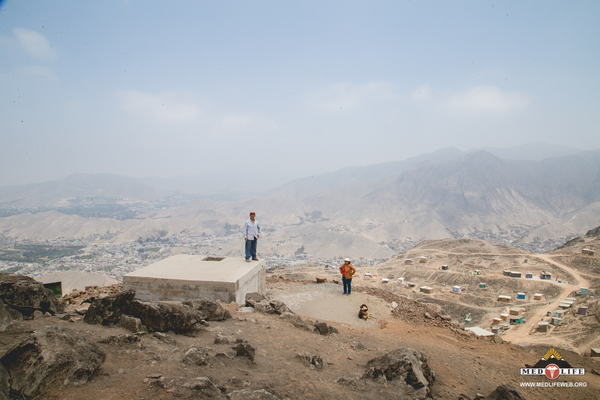If one only visits Lima’s developed and wealthier districts like Miraflores, San Isidro, Surco, or San Borja, in can be hard to tell that Lima is a city located in the desert and one of the driest capital cities in the world. But if you the continue driving into what are known as “los conos†on the city’s periphery, to the north, east, and south, within a few blocks the view changes dramatically and the realities of the desert are revealed as dusty hills covered in shantytowns stretching as far as the eye can see. In many of the low-income communities that cover the hills known as “pueblos jovenes” or “asentamientos humanos,” the resources, community organization and urban planning are not capable of turning the desert green. Far from it, many people don’t even have adequate access to drinkable water. Overcoming significant barriers to access water is one of the most pressing daily hardships faced by the residents of Lima’s perpetually dusty slums.
.
The city has about 91% water coverage and 90% sewage according to the World Bank. However, the reality is that half of the population receives unsafe water and the poorest communities in “los conos,†at least half a million people are dependent on private water vendors that sell the water at up to 12 times the price of a public utility (2).
To make matters worse, the poorest residents live in communities at the top of the hills that often have no road access or even a staircase to make the climb easier. The water trucks only drive to where there is road access and make infrequent trips to many communities, so residents are forced to walk long distances to get to the water trucks, and then carry the water up to their homes. In Lima, the poor pay the most for water economically and with their time and labor.
Most of the communities that are not connected to Lima’s public water utility, SEDAPAL, because they do not have the land title to the land they settled on and are thus not legally recognized by the government. This is compounded by a total lack of roads, or by roads that are mere loose dirt paths and not driveable by construction limiting access into the communities.
The government has put in place several programs to attempt to improve water access, the most prominent of which was called “Agua Para Todos,†launched in 2007. Despite a huge investment of public funds, the results have failed to reach vast stretches of the conos. Edomia Poma Pallcarcajo, a community organizer in Los Jardines has worked for years to try and get the government to connect her community to the public water utility with little success.

“We tried to wait for the government to bring us “agua para todos,†but the years passed, and now we are old. Jardines has been here for 24 years. I got here when I was 19, now I am 42.â€
In 2015, Jardines asked SEDAPAL how they could access the benefits of the program. They told the community that in five or ten years, they could get connected.
“Then, I will be in my fifties,†Edomia said. “ I don’t want to still be without water.â€
In 2011 Agua Para Todos was investigated by the Peruvian National Congress and found that the program, along with the public utility SEDAPAL had been badly mismanaged with a cost of around $1.5 billion USD was accused of fraud. Antonio Iorvis, who has written extensively on the commodification of water and in particular Lima’s water system, concluded that Agua Para Todos clearly shows that a large investment of public funds does not guarantee improve water services or water scarcity. (1)
In light the dismal state of the public water service, Edomia and the community of Jardines decided to take matters into their own hands and contracted a private company to build the infrastructure for them. One year later, Jardines is ready to connect to SEDAPAL. They will have water pumped directly into their homes for half the monthly cost of buying water from water trucks. The downside is that this project cost each household 1500 soles (about $500), a very high price to pay for low-income residents in Lima.
Privatized Water
Internationally, water privatization has been advanced as a solution to government failures to provide water, as seen in Lima. Joanna Robinson sums up the logic in her book about water privatization:
“Some argue that water privatization was promoted as a lucrative investment for the private sector and a way for governments to allocate resources more efficiently, more recently private sector water delivery has been endorsed and encouraged by the World Bank and other global financial institutions, as a way of correcting the failures of public water management, including increasing environmental conservation, reducing social and economic inequities—particularly in developing countries—and providing clean water to the billions of people who currently lack access worldwide. Since the 1980s, public water systems have been under attack by proponents of market-based models of governance, who argue that “governments are less productive, efficient, and effective than markets.â€With the massive governance failure on the part of the public sector, including poor planning, crumbling infrastructure, and pollution and degradation of water systems, private sector involvement in water systems has been hailed as a means of correcting those failures and increasing equity in terms of access to and affordability of water services by poor and marginalized populations.†(2)
In 2000, more than 460 million people had their water supplied by transnational water firms and that number has only continued to grow (2). The results of this effort have been mixed internationally and sparked heated debate, with many critics arguing that privatization is another form of neo-colonialism, and proponents on the other side of the debate arguing that it serves to spread access and increase efficiency.
In Lima, news that the government was considering privatizing SEDAPAL caused large protests that blocked traffic on major roads. Protesters cited fear of increased tariffs, high buy in costs like those in Jardines and the extremely poor and expensive service for those currently being serviced by private water truck companies as reasons why privatization should be opposed.
Although some communities like Jardines have been able to construct their own water infrastructure, many cannot afford this, and high cost and constant struggle to procure basic necessities like water is a constant burden that holds communities back from moving forward. MEDLIFE recognizes that one of the best ways to empower communities is to alleviate this burden, and so help communities improve water access in whatever way we can.
How MEDLIFE Works to Improve Water Access
If a community can get the government to pay to build them the infrastructure, this is the best solution, but fulfilling the requirements is costly and there is no funding from the government for these sorts of projects. Along with being useful to communities in their own right, many MEDLIFE development projects serve to complete the requirements for both water connection and land titles.
Communities need road access and a safe entrance and exit from communities. This can be very difficult, as these communities were built without any urban planning oversight, and thus are often built on land that would never be chosen by a developer. Retention walls must often first be constructed to stabilize the land for construction and to prevent rockslides. MEDLIFE staircases fulfill the requirement of a safe entrance and exit.
MEDLIFE is in the process of building a road in one of the communities we have worked in the most, Union De Santa Fe. This road, combined with the many staircases and the retention wall MEDLIFE has built should qualify Union Santa Fe for connection to SEDAPAL. However Union Santa Fe Community Organizer Casani, who is working with SEDAPAL to organize the connection says that even after a six year development process process of building the staircases and the roads with MEDLIFE to improve infrastructure and help Union Santa Fe meet SEDAPAL requirements, the process will take around three years.
We know that the families of Union De Santa Fe and countless other communities could not wait that long when they are thirsty today. We built a water pylon like the one in Jardines that connects to the SEDAPAL system down the hill and brings water directly into residents homes in Union de Santa Fe and now they have affordable water in their homes.

However, sometimes, it is not possible to construct a Pylon to connect to the public utility, as many communities are located far away from connection points to the SEDAPAL system on very poor sites for construction. Meeting requirements would be extremely expensive and time consuming in these places, and then it could take years for the government to get around to doing the project.
In Urucancha, for example, a community in the Southern Cone that is located on the top of the hill that separates La Molina, one of the wealthiest areas, from Pamplona Alta, one of the poorest, a pylon project was not feasible. Yet Urucancha was badly in need of better water access, the water trucks only drove that high on the hill about every two weeks and residents had no way to store enough water to last that long. Recently, the water trucks have decided that the amount of water Urucacha was purchasing wasn’t worth the long trip up the hill, so they didn’t come for 6 weeks, leaving the residents with no option but to make the 40 minute steep hike from the next nearest water stop carrying their water.
Lack of water is Urucancha’s main problem, but storing water in sanitary conditions for long periods was also an issue. The big open barrels of water that can be cheaply purchased by residents to store water often become unsanitary and contaminated with “green fungus,†as reported to us by many residents.

In this case, MEDLIFE constructed a huge tank that could be filled by the water trucks and leave the community with enough water to last between visits. The tanks are sealed, and thus will keep the water clean from contamination. The trucks will make the trip often enough to keep the tanks filled, because they are now selling in bulk, which also reduces cost. This project brings water to 150 families.
We knew we could reach more people, so we are currently constructing a larger and more ambitious water tank project that will be able to service several communities at once higher on hillsides in Laderas. We are building three water tanks that will be filled by water trucks and then funnel water directly to the homes of 220 families and around 1000 residents. This will be our largest water project yet, and we won’t stop here.

Sources:
2: Robinson, Joanna L. “1.” Contested Water: The Struggle against Water Privatization in the United States and Canada. Cambridge, MA: MIT, 2013. N. pag. Print.
